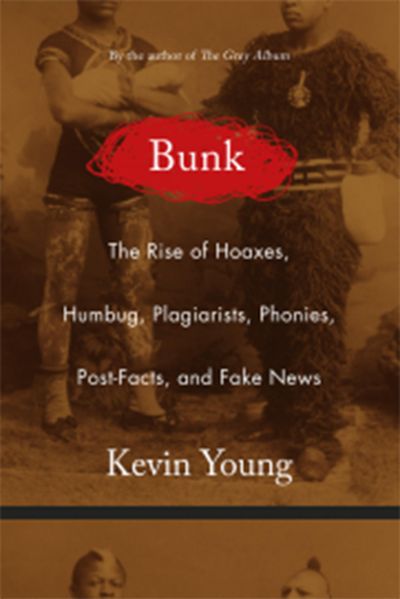Author Kevin Young discusses hoaxes, fake news and other untruths

“Beware of stories you want to be true, for whatever reason,” journalist Ben Bradlee once wrote. It’s a quote that appears prominently in Kevin Young’s rich, detailed nonfiction work “Bunk: The Rise of Hoaxes, Humbug, Plagiarists, Phonies, Post-Facts and Fake News,” a book brimming with stories from the past and near-present – each of them with an untruth, to some degree, at its core.
Young said in a telephone interview last month that he spent six years researching the book, finding stories ranging from P.T. Barnum’s famously fake sideshows to the Cottingley Fairies hoax to the recent journalism scandals involving Stephen Glass and Jayson Blair.
“It was very much a process of recovery. A lot of archival work, a lot of tracking down books and buying them when I could, to sort of track the hoax in its natural habitat,” he said, noting that some past books about hoaxes seemed to miss the mark. “They said it was about the blurry line between fact and fiction, but in fact they hadn’t read the hoaxes in question. I wanted to take that extra step and read them and see what they were like, but also see the ways that they were about something much more.”
What he found was that so many of the stories – Joice Heth, an elderly slave exhibited by Barnum as George Washington’s wet-nurse; the Dreadnought Hoax; Susan Smith; Rachel Dolezal; Janet Cooke – had something in common. “For much of the hoaxes, they seemed to rely on race in big and small ways. It seemed so obvious once I started down that road,” he said. “I was blown away by how often it happened, and blown away by how little people mentioned that. It really became important to trace that. I think once I did, it went beyond from saying this is about race, to understanding the ways that race and the hoax, in the modern sense, grew up together, and how they reinforce each other.”
In the book, he asks, “Do so many hoaxes involve race – indeed, seem to require race in order to properly function – because race is the ultimate white elephant? Or is it that only in the narrative of race in America does the outrageous seem not only possible but also inevitable, has happened and will again?”
Young’s initial interest in the topic was sparked by a boss he had while an undergraduate, Ravi Desai – who later was revealed to be a serial hoaxer. (Among many incidents: Desai promised $2 million to the University of Washington; a gift that failed to materialize.) “It’s almost hard to talk about,” Young said, of that time in the early 1990s. “We worked together, and you want to believe what people say. He told us, for instance, that he had cancer. Later you look back and say, I don’t think that was true. When you’re 19 or 20, you don’t know what cancer looks like. He was bald within like two days – he shaved his head.”
As engrossing as the work on “Bunk” has been, it’s had to coincide with Young’s other passions. An acclaimed poet, he has published 10 books of poetry, as well as the 2012 nonfiction work “The Grey Album: On the Blackness of Blackness,” which won the PEN Open Book Award. He is the director of the Schomburg Center for Research in Black Culture, in Harlem, and recently became poetry editor of The New Yorker. (Does he sleep? “I get that question a lot,” he said, “but yes, I do sleep.”)
At the Schomburg Center, a research unit of the New York Public Library (watch for a cameo appearance by Young in the recent documentary about the NYPL, “Ex Libris”), Young immerses himself in curation; what he called, in “The Grey Album,” “the willed recovery of what’s been lost.”
A new exhibit celebrates a lesser-known voice: the groundbreaking filmmaker Kathleen Collins, whose 1982 drama “Losing Ground” is one of the first (perhaps the first) theatrically released feature-length film directed by a black woman. Collins, who died at the age of 46, also wrote fiction, and the Schomburg has acquired a collection of her papers. “We’re really excited to honor her as a filmmaker and a writer and a creator,” said Young.
And at The New Yorker, where he just began his position as poetry editor this month, Young is looking forward to finding new voices.
Young said that about 30 percent of the poetry that appears in the magazine has arrived over the transom, unsolicited. “I think that’s really important,” he said. “There was someone who I didn’t know the other day whose work was terrific, and it’s going to be in the magazine.” Like research and curation, it’s a way to celebrate serendipitous findings; to bring light to something that might otherwise be lost.